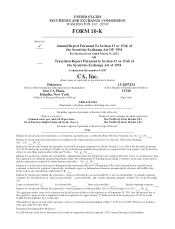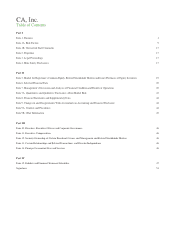Computer Associates 2012 Annual Report Download - page 18
Download and view the complete annual report
Please find page 18 of the 2012 Computer Associates annual report below. You can navigate through the pages in the report by either clicking on the pages listed below, or by using the keyword search tool below to find specific information within the annual report.
Sales and Marketing
We offer our solutions through our direct sales force and indirectly through our strategic partners. Our sales and marketing processes
include carefully managing the customer lifecycle by continually improving the customer experience from purchase to deployment
and beyond.
We rely on market analysis and customer insight to help us identify new market opportunities and provide fact-based insight on
industry and customer trends, and we rely on our marketing organization to build awareness of and demand for our products
worldwide.
Our sales organization operates globally. We operate through branches, subsidiaries and partners around the world. Approximately
42% of our revenue in fiscal 2012 was from operations outside of the United States. As of March 31, 2012, and March 31, 2011, we
had approximately 3,600 and 3,500 sales and sales support personnel, respectively.
Customer Success Lifecycle
Our customer success lifecycle program brings together professional services, education, support, communities and partners to help
customers from software installation through use. Our efforts are intended to provide a positive customer experience and increase
customer loyalty.
We work with customers to deploy our solutions quickly and effectively so they are able to derive greater value from their software
investments. We offer ongoing, best-practice guidance for using our installed solutions, which helps customers avoid inefficiencies
and use all of the software features that address their business challenges. We also provide networking opportunities through user
groups and communities that enable customers to connect and share with each other, as well as partners and CA Technologies
experts.
We have more than 32,000 distinct community members in 44 active online communities where users network with each other, ask
and answer questions and share knowledge about CA Technologies solutions. Through our communities, customers have the
opportunity to engage with their peers as well as gain access to CA Technologies technical experts, to provide their ideas and input
on product direction, vote on those ideas and receive feedback from CA Technologies.
Research and Development
We have approximately 5,900 employees globally who design and support CA Technologies software. Our engineers are organized
through six regional hubs located in Framingham, Massachusetts; Plano, Texas; Redwood City, Petaluma and San Francisco,
California; Prague, the Czech Republic; Hyderabad, India; and Beijing, China. Our engineers work collaboratively in both physical
and virtual labs, increasingly using an agile development methodology. Among other things, agile development is intended to enable
the incorporation of new customer insights, which in turn strengthens our ability to bring to market innovations that deliver business
value to our customers.
Our research and development activities also include a number of efforts to support our technical community in its pursuit of leading
solutions for customers. We continue to use CA Technologies Labs on Demand to strengthen our relationships with research
communities by working with academia, professional associations, industry standards bodies, customers and partners to explore novel
products and emerging technologies. Our CA Council for Technical Excellence leads innovative projects designed to promote
communication, collaboration and synergy throughout our global technical community. The CA Architecture Board helps us ensure a
strong central architecture that supports our growth strategy, and our Distinguished Engineer Board encourages and recognizes
excellence in engineering.
To keep us on top of major technological advances and to ensure our products continue to work well with those of other vendors, we
are active in most major industry standards organizations and take the lead on many issues. Our professionals are certified across key
standards, including Scrum Alliance (a non-profit organization focused on Scrum framework, which is related to agile development
methodology), ITIL®, PMI and CISPP, and are certified in CSM (Certified Scrum Master) and CSP (Certified Scrum Professional) to
lead the charge in implementing agile practices and methodologies across the Company. Our professionals also possess knowledge
and expertise in key vertical markets, such as financial services, government, telecommunications, insurance, health care,
manufacturing and retail. Further, we were the first major software company to earn the ISO’s 9001:2000 Global Certification. In
addition, our Global IT Operations have attained ISO/IEC 20000-1:2005 and ISO/IEC 27001:2005 certifications. These certifications
demonstrate our leadership in IT service management and information security.
We have charged to operations $510 million, $471 million and $487 million in fiscal 2012, 2011 and 2010, respectively, for product
development and enhancements. In fiscal 2012, 2011 and 2010, we capitalized costs of $180 million, $170 million and $188 million,
respectively, for internally developed software.
6
























